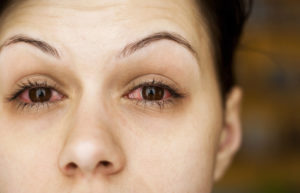October 19, 2015 | Black & Kletz Allergy

Various types and causes:
- Allergic Conjunctivitis: Some of us are genetically predisposed to form antibodies called IgE (as opposed to infection fighting antibodies called IgG) against common environmental agents like pollen, dust mites, molds, and animal dander. When these agents come in contact with the conjunctival membrane, the IgE interacts with them causing chemicals like histamine to be released from certain cells. These chemicals produce symptoms like itching, redness, excessive tearing, etc. Pollens from trees and grasses cause these symptoms mainly in spring and pollen from ragweed causes the fall symptoms, whereas indoor allergens like dust mites, pets, and cockroach cause symptoms throughout the year. This allergic eye condition is very common.
- Vernal Keratoconjunctivitis: This allergic eye disorder causes long term and severe inflammation of the conjunctivae which is typically seen around the spring and the summer. It is rare in cold climates and much more common in subtropical and tropical areas. It predominantly involves pre-pubertal boys and usually resolves itself after a few years. Patients frequently have a personal or family history of allergic rhinitis, asthma, and/or eczema. In addition to redness and intense itching, a thick ropy discharge from the eyes is a common feature. The insides of the eyelids appear like a cobblestone due to swollen tissues. The junction between the white part and the iris (the part of the eye that is usually brown, blue, hazel, etc.) of the eye called the limbus also becomes swollen and looks more prominent. In about 6% of individuals, it can affect the cornea, which may cause photophobia (difficulty in looking at bright light) and can lead to corneal scarring, glaucoma, or cataracts, resulting in decreased vision and/or blindness. In these cases laser therapy and/or surgical intervention may be necessary to treat the corneal involvement.
- Atopic Keratoconjunctivitis: This allergic eye condition is usually associated with eczema of the skin in various parts of the body. The skin over the eyelids is often involved causing swelling and excessive wrinkling of the skin. The predominant symptom is severe itching of the skin over the eyelids (more commonly involves the lower eyelids on both sides). Atopic keratoconjunctivitis usually starts in second or third decade of life and can become less or more severe over the years, often paralleling the activity level of skin eczema. The symptoms are perennial in nature with this disorder. It is also more common in individuals who have asthma and/or allergic rhinitis. As with vernal keratoconjunctivitis, in some individuals, it may affect their cornea which can cause photophobia and potentially lead to decreased vision and/or blindness by causing scarring of the cornea.
- Giant Papillary Conjunctivitis: Excessive tissue growths called papillae form under the upper eyelids on both sides causing severe itching and discomfort, a foreign body sensation, and/or blurry vision. There is often a ropy discharge from the eyes in this allergic eye condition. This condition is thought to result from an allergic reaction either to contact lenses or to the solution used to clean the lenses. Deposits over the contact lenses in conjunction with constant rubbing with the insides of the lids lead to friction and severe irritation eventually leading to the formation of large papillae.
- Reactive Conjunctivitis: Excessive sensitivity to chemicals in swimming pools, fumes, smoke, foreign bodies, etc. can result in irritation of the conjunctivae causing redness, burning, and/or watery eyes.
- Infectious Conjunctivitis: This highly contagious form of eye infection is most commonly caused either by a virus or bacteria. Viral infections generally produce copious amounts of clear discharge from the eyes in addition to redness and itching. Bacterial infections, on the other hand, are usually associated with thicker and discolored secretions. Dried up secretions cause the eyelids to mat together making it difficult to open one’s eyes in the morning. Apart from redness and a gritty feeling in the eyes, some people also experience photophobia. Infectious conjunctivitis tends to affect one eye more often than allergic eye disorders which usually involve both eyes. Nevertheless, infectious conjunctivitis may also affect both eyes. Most infections resolve spontaneously in about a week to ten days, though the duration of the bacterial conjunctivitis can sometimes be cut short by using antibiotic eye drops.
Treatment:
Avoidance of exposure to the known triggering agents is the predominant modality of prevention, as is the case with most other allergic disorders.
Antihistamine pills and/or eye drops are helpful in relieving the itching and redness of the eyes. It should be noted that some types of over the counter eye drops containing medications that constrict the blood vessels may cause rebound symptoms which may paradoxically worsen the condition over the long term. In severe cases unresponsive to antihistamines, steroid and non-steroidal eye medications may need to be employed to provide relief. Allergy immunotherapy (i.e., allergy shots, allergy injections) is very effective in the treatment and prevention of various allergic eye disorders. Laser and/or surgical intervention may occasionally be necessary in cases of corneal involvement with both vernal keratoconjunctivitis and atopic keratoconjunctivitis.
The board certified allergists at Black & Kletz Allergy have decades of experience and expertise in evaluating and treating the various conditions which cause itching, redness, and/or excessive discharge from the eyes. We see both adults and children and have 3 convenient office locations in the Washington, DC, Northern Virginia, and Maryland metropolitan area, with on-site parking at all 3 offices. The Washington, DC and McLean, VA locations are also Metro accessible with a free shuttle that takes patients to and from the Spring Hill station to our McLean, VA office. If you are suffering from any one of the eye symptoms mentioned above or any other allergy symptoms, please call our office for an appointment. Alternatively, you can click Request an Appointment and we will respond back to you within 24 hours of the next business day.












